light OLDSMOBILE INTRIGUE 1998 Repair Manual
[x] Cancel search | Manufacturer: OLDSMOBILE, Model Year: 1998, Model line: INTRIGUE, Model: OLDSMOBILE INTRIGUE 1998Pages: 340, PDF Size: 17.93 MB
Page 243 of 340

How to Reset the CHANGE OIL Light
After changing the engine oil, the system must be reset
1.
2.
3.
With the ignition key in ON but the engine off, fully
push and release the accelerator pedal slowly three
times within five seconds.
If the CHANGE OIL light flashes, the system
is resetting.
Turn the key to OFF, then start the vehicle. If the
CHANGE OIL light comes back on, the engine oil
life monitor has not reset. Repeat the procedure.
What to Do with Used Oil
Did you know that used engine oil contains certain
elements that may be unhealthy for your skin and could
even cause cancer? Don’t let used oil stay on your skin
for very long. Clean your skin and nails with soap and
water, or a good hand cleaner. Wash or properly throw
away clothing or rags containing used engine oil. (See
the manufacturer’s warnings about the use and disposal
of oil products.)
Used oil can be a real threat to the environment.
If you
change your own oil, be sure to drain all free-flowing oil
from the filter before disposal. Don’t ever dispose of oil
by putting
it in the trash, pouring it on the ground, into
sewers, or into streams or bodies of water. Instead,
recycle it by taking it to a place that collects used oil.
If
you have a problem properly disposing of your used oil,
ask your retailer,
a service station or a local recycling
center for help.
6-15
ProCarManuals.com
Page 249 of 340
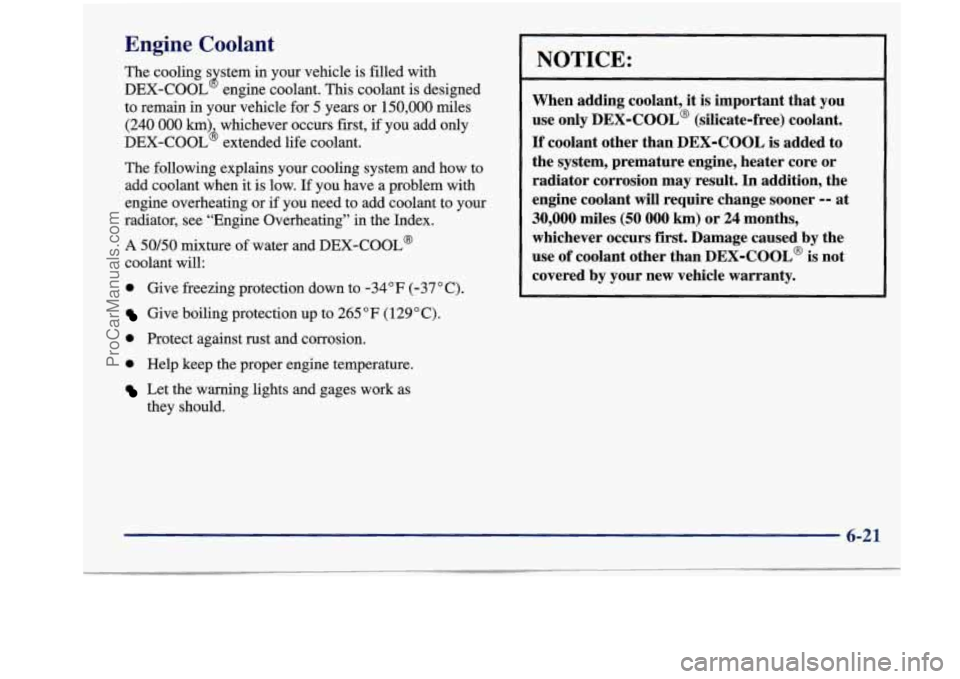
Engine Coolant
The cooling s stem in your vehcle is filled with
DEX-COOL
J engine coolant. This coolant is designed
to remain in your vehicle for
5 years or 150,000 miles
(240
000 km) whichever occurs first, if you add only
DEX-COOL’ extended life coolant.
The following explains your cooling system and how to
add coolant when it is low. If you have a problem with
engine overheating
or if you need to add coolant to your
radiator, see “Engine Overheating” in the Index.
A 50150 mixture of water and DEX-COOL@
coolant will:
0 Give freezing protection down to -34°F (-37°C).
Give boiling protection up to 265 “F (129°C).
0 Protect against rust and corrosion.
0 Help keep the proper engine temperature.
Let the warning lights and gages work as
they should.
NOTICE:
When adding coolant, it is important that you
use only
DEX-COOL@ (silicate-free) coolant.
If coolant other than DEX-COOL is added to
the system, premature engine, heater core
or
radiator corrosion may result. In addition, the
engine coolant will require change sooner
-- at
30,000 miles (50 000 km) or 24 months,
whichever occurs first. Damage caused by the
use of coolant other than DEX-COOL@ is not
covered by your new vehicle warranty.
6-21
ProCarManuals.com
Page 251 of 340
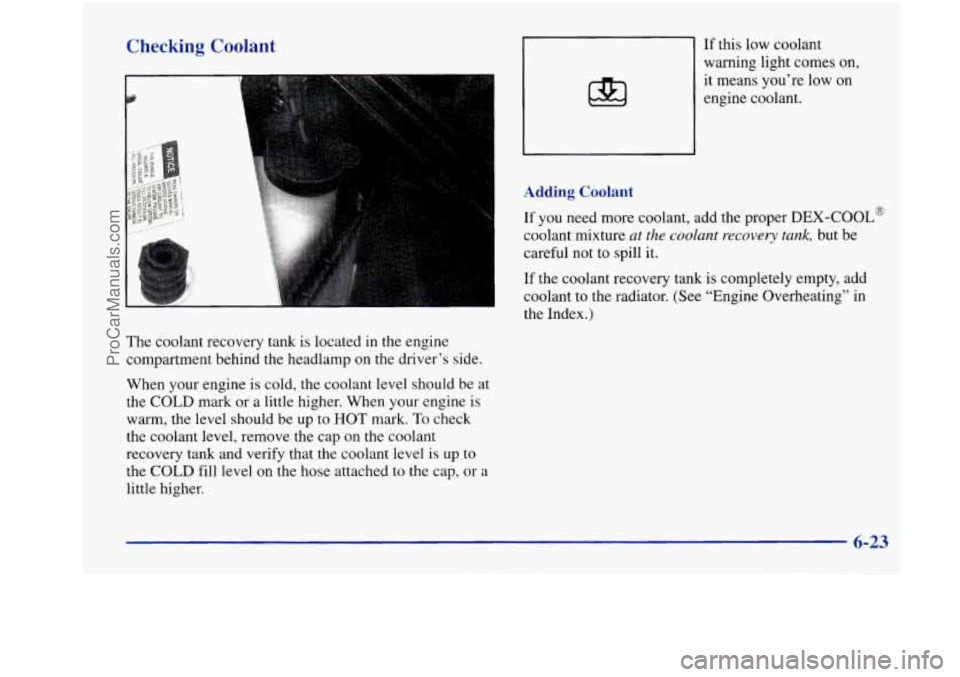
Checking Coolant
The coolant recovery tank is located in the engine
compartment behind the headlamp on
the driver’s side.
When your engine is cold, the coolant level should be at
the COLD mark or a little higher. When your engine is
warm, the level should be up to
HOT mark. To check
the coolant level, remove the cap on the coolant
recovery tank and verify that the coolant level is up to
the COLD fill level on the hose attached to
the cap, or a
little higher.
&I If this low coolant
warning light comes on,
it means you’re low on
engine coolant.
Adding Coolant
If you need more coolant, add the proper DEX-COOL@
coolant mixture
at the coolant recovery tank, but be
careful not to spill it.
If the coolant recovery tank is completely empty, add
coolant to
the radiator. (See “Engine Overheating” in
the Index.)
6-23
ProCarManuals.com
Page 255 of 340

Brakes
Brake Fluid
goes back up. The other reason is that fluid is leaking out
of the brake system. If it is, you should have your brake
system fixed, since a leak means that sooner or later your
brakes won’t work
well, or won’t work at all.
So, it isn’t a good idea to “top off’ your brake fluid.
Adding brake fluid won’t correct
a leak. If you add fluid
when your linings are worn, then you’ll have too much
fluid when you get new brake linings. You should add
(or remove) brake fluid,
as necessary, only when work is
done on the brake hydraulic system.
Your brake master cylinder reservoir
is here. It is filled
with
DOT-3 brake fluid.
There are only two reasons why the brake fluid level
in the
reservoir might go down. The first is that the brake fluid
goes down to
an acceptable level during normal brake
lining wear.
When new linings are put in, the fluid level
If’ you have too much brake fluid, it can spa on the
engine. The fluid
will burn if‘ the engine is hot
enough. You or others could be burned, and
your
vehicle could be damaged. Add brake fluid only
when work
is done on the brake hydraulic system.
When your brake fluid falls to a low level, your brake
warning light will come on. See “Brake System Warning
Light”
in the Index.
6-27
ProCarManuals.com
Page 257 of 340
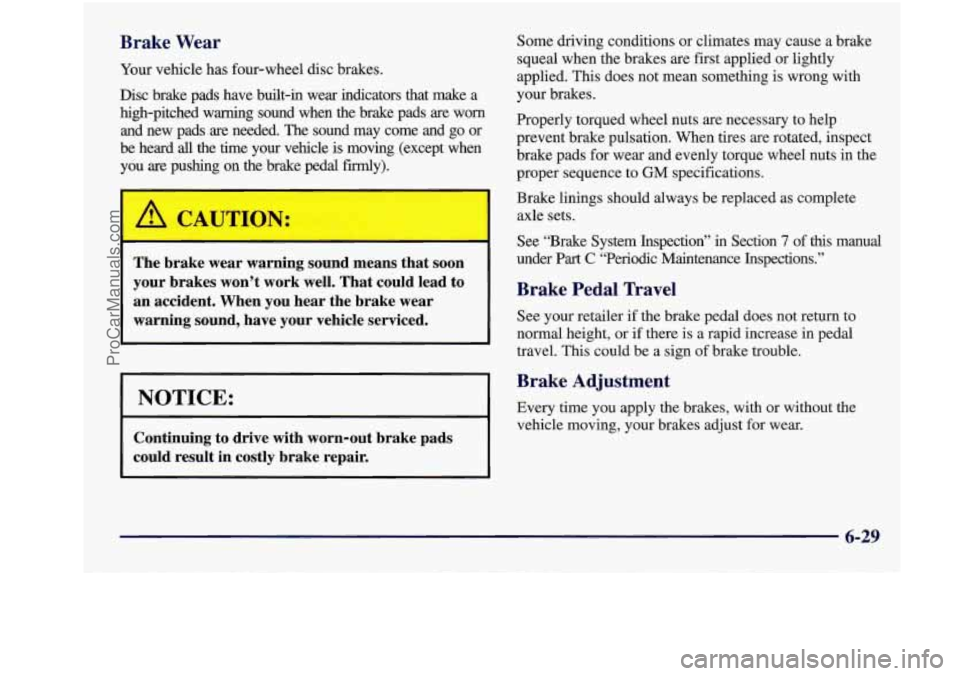
Brake Wear
Your vehicle has four-wheel disc brakes.
Disc brake pads have built-in wear indicators that make a
high-pitched warning sound when the brake pads are worn and new pads are needed. The sound may come and
go or
be heard all the time your vehicle is moving (except when
you are pushing on the brake
pedal firmly).
- m--
A CAUTION:
I
The brake wear warning sound means that soon
your brakes won’t work well. That could lead to
an accident. When you hear the brake wear
warning sound, have your vehicle serviced.
NOTICE:
Continuing to drive with worn-out brake pads
could result in costly brake repair.
Some driving conditions or climates may cause a brake
squeal when the brakes are first applied or lightly
applied. This does not mean something is wrong with
your brakes.
Properly torqued wheel nuts are necessary to help
prevent brake pulsation. When tires are rotated, inspect
brake pads for wear and evenly torque wheel nuts in the
proper sequence to
GM specifications.
Brake linings should always be replaced as complete
axle sets.
See “Brake System Inspection” in Section
7 of this manual
under Part
C “Periodic Maintenance Inspections.”
Brake Pedal Travel
See your retailer if the brake pedal does not return to
normal height, or if there is
a rapid increase in pedal
travel. This could be a sign of brake trouble.
Brake Adjustment
Every time you apply the brakes, with or without the
vehicle moving, your brakes adjust for wear.
6-29
ProCarManuals.com
Page 271 of 340

Mixing tires could cause you to lose control while
driving. If you mix tires of different sizes or types
(radial and bias-belted tires), the vehicle may not
handle properly, and you could have
a crash.
Using tires of different sizes may also cause
damage to your vehicle. Be sure to use the same
size and type tires on
all wheels.
It’s all right to drive with your compact spare,
though. It was developed for use on your vehicle.
I A CAUTION:
If you use bias-ply tires on your vehicle, the
wheel rim flanges could develop cracks after
many miles of driving.
A tire and/or wheel could
fail suddenly, causing
a crash. Use only radial-ply
tires with the wheels on your vehicle.
Uniform Tire Quality Grading
The following information relates to the system
developed by the United States National Highway
Traffic Safety Administration, which grades tires
by
treadwear, traction and temperature performance. (This
applies only to vehicles
sold in the United States.) The
grades are molded on the sidewalls of most passenger
car tires. The Uniform Tire Quality Grading system does
not apply to deep tread, winter-type snow tires,
space-saver or temporary use spare tires, tires with
nominal rim diameters
of 10 to 12 inches (25 to 30 cm),
or
to some limited-production tires.
While the tires available on General Motors passenger
cars and light trucks may vary with respect
to these
grades, they must also conform to Federal safety
requirements and additional General Motors Tire
Performance Criteria (TPC) standards.
6-43
ProCarManuals.com
Page 282 of 340
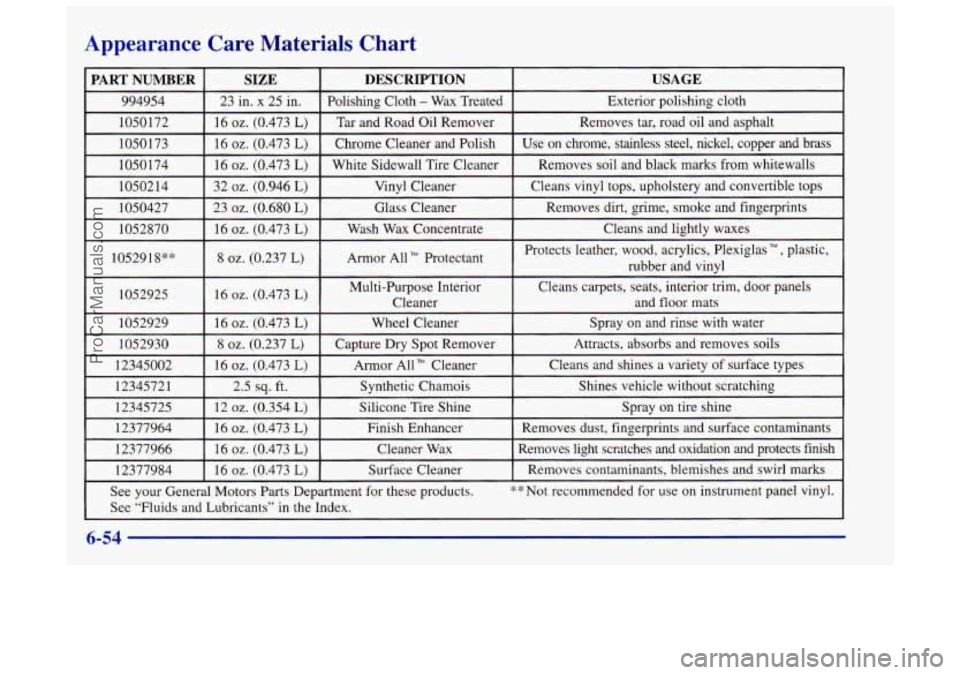
Appearance Care Materials Chart
PART NUMBER I SIZE DESCRIPTION USAGE I
994954
Exterior polishing cloth
Polishing Cloth - Wax
Treated
23 in. x 25 in.
1050172 Removes tar, road oil and asphalt
Tar and Road Oil Remover
16
oz. (0.473 L)
1050173
Cleans vinyl tops, upholstery and convertible tops
Vinyl Cleaner
32
oz. (0.946 L) 1050214 Removes soil and black marks
from whitewalls
White Sidewall Tire Cleaner
16
oz. (0.473 L) 1050174 Use on chrome, stainless steel, nickel, copper and brass
Chrome Cleaner and Polish
16
oz. (0.473 L)
1050427
Cleans and lightly waxes
Wash Wax Concentrate
16
oz. (0.473 L) 1052870 Removes
dirt, grime, smoke and fingerprints
Glass Cleaner
23
oz. (0.680 L)
--
1052918**
Armor All TM Protectant
8 oz. (0.237 L) Protects leather, wood, acrylics, Plexiglas TM, plastic,
rubber and vinyl
1052925
I 16 oz. (0.473 L) I Multi-Purpose Interior Cleans carpets, seats, interior trim, door panels
I Cleaner and floor mats I
1052929 16 oz. (0.473 L)
1052930 8 oz. (0.237 L)
12377964
16 oz. (0.473 L)
Wheel Cleaner Spray on and rinse with water
Capture Dry Spot Remover Attracts, absorbs and removes soils
Armor
All TM Cleaner Cleans and shines a variety of surface types
Synthetic Chamois Shines vehicle without scratching
_____~
Silicone Tire Shine Spray on tire shine
Finish Enhancer Removes dust, fingerprints and surface contaminants
12377966 16
oz. (0.473 L) Cleaner Wax Removes light scratches and oxidation and protects finish
12377984 16
02. (0.473 L) Surface Cleaner Removes
contaminants, blemishes and swirl marks
See your General Motors Parts Department
for these products. ** Not recommended for use on instrument panel vinyl.
See “Fluids and Lubricants” in the Index.
6-54
ProCarManuals.com
Page 286 of 340
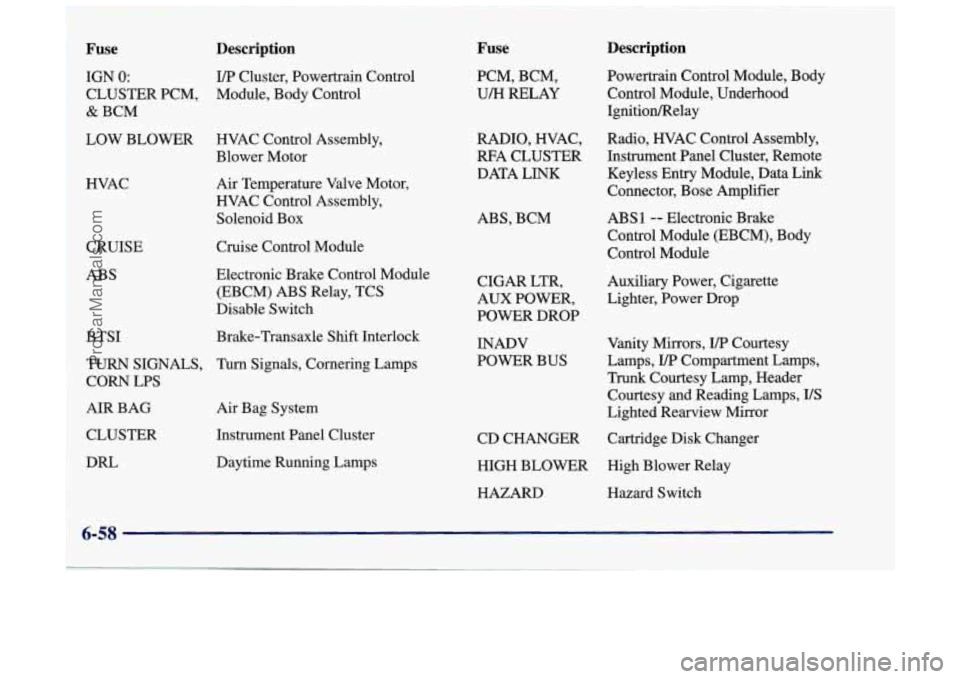
I Fuse Description
Fuse
IGN 0: I/P Cluster, Powertrain Control
1 CLUSTER PCM, Module, Body Control
I &BCM I
1 LOW BLOWER HVAC
Control Assembly,
Blower Motor
~ HVAC
CRUISE
ABS
BTSI Air Temperature
Valve Motor,
HVAC Control Assembly,
Solenoid Box
Cruise Control Module
Electronic Brake Control Module (EBCM) ABS Relay, TCS
Disable Switch
Brake-Transaxle Shift Interlock
TURN SIGNALS, Turn Signals, Cornering Lamps CORN LPS
AIR BAG
CLUSTER
DRL Air
Bag System
Instrument Panel Cluster
Daytime Running Lamps PCM, BCM,
U/H RELAY
RADIO, WAC,
RFA CLUSTER
DATA LINK
ABS, BCM
CIGAR LTR,
AUX POWER,
POWER DROP INADV
POWER BUS
Description
Powertrain Control Module, Body
Control Module, Underhood
IgnitiodRelay
Radio, HVAC Control Assembly,
Instrument Panel Cluster, Remote
Keyless Entry Module, Data
Link
Connector, Bose Amplifier
ABS1 -- Electronic Brake
Control Module (EBCM), Body
Control Module
Auxiliary Power, Cigarette
Lighter, Power Drop
Vanity Mirrors,
I/P Courtesy
Lamps,
I/P Compartment Lamps,
Trunk Courtesy Lamp, Header Courtesy and Reading Lamps,
US
Lighted Rearview Mirror
CD CHANGER Cartridge Disk Changer
HIGH BLOWER High Blower Relay
HAZARD Hazard Switch
i 6-58
ProCarManuals.com
Page 289 of 340
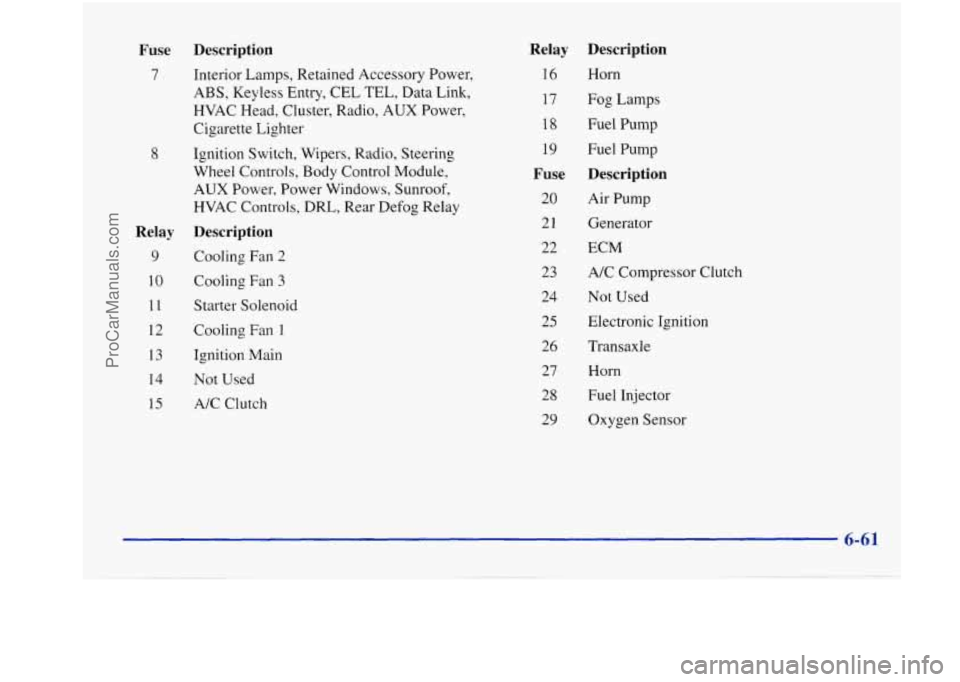
Fuse Description
7 Interior Lamps, Retained Accessory Power,
ABS, Keyless Entry, CEL TEL, Data Link,
HVAC Head, Cluster, Radio, AUX Power,
Cigarette Lighter
8 Ignition Switch, Wipers, Radio, Steering
Wheel Controls, Body Control Module,
AUX Power, Power Windows, Sunroof,
HVAC Controls, DRL, Rear Defog Relay
Relay Description
9 Cooling Fan 2
10 Cooling Fan 3
11 Starter Solenoid
12 Cooling Fan 1
13 Ignition Main
14 Not Used
15 A/C Clutch
Relay
16
17
18
19
Fuse
20
21
22
23
24
25
26
27
28
29
Description
Horn
Fog Lamps Fuel Pump
Fuel Pump
Description
Air Pump
Generator
ECM A/C Compressor Clutch
Not Used
Electronic Ignition
Transaxle
Horn Fuel Injector
Oxygen Sensor
ProCarManuals.com
Page 297 of 340

I Maintenance Schedule I
The services shown in this schedule up to 100,000 miles
(I 66 000 km) should be performed after 100,000 miles
(1
66 000 km) at the same intervals. The services shown
at
150,000 miles (240 000 km) should be performed at
the same interval after
150,000 miles (240 000 km).
See “Owner Checks and Services” and “Periodic
Maintenance Inspections” following.
Footnotes
? The U.S. Environmental Protection Agency or the
California Air Resources Board has determined that the
failure to perform this maintenance item will not nullify
the emission warranty or limit recall liability prior to
the completion of the vehicle‘s useful life. We, however,
urge that all recommended maintenance services
be performed at the indicated intervals and the
maintenance be recorded.
* Your vehicle has an Engine Oil Life Monitor. This
monitor will show
you when to change the engine oil
and filter
-- usually between 3,000 miles (5 000 km)
and
7,500 miles (12 500 km) since your last oil change.
Under severe conditions, the indicator may come on
before
3,000 miles (5 000 km). Never drive your vehicle
more than
7,500 miles (12 500 km) or 12 months
without an oil and filter change.
The system won’t detect dust in the oil.
So if you
drive
in a dusty area, be sure to change your oil and
filter every
3,000 miles (5 000 km) or sooner if the
CHANGE
OIL light comes on. Remember to reset the
Oil Life Monitor when the oil has been changed.
For
more information, see “Engine Oil” in the Index.
+ A good time to check your brakes is during tire
rotation. See “Brake System Inspection’’ unde.r “Periodic
Maintenance Inspections” in Part C
of this schedule.
7-5
ProCarManuals.com